Batavia Muckdogs – July 15, 2018
Despite being only 4.5 hours from my front door, Dwyer Stadium, home of the Batavia Muckdogs, isn’t a place that I’d previously managed to visit since I launched The Ballpark Guide in 2010. And while I’d visited Rochester’s Frontier Field — just 45 minutes from Batavia — five separate times and zipped along I-90 past Batavia more times than I can count, this New York-Penn League team had never made it onto my road trip schedule.
Half of the issue has been scheduling. Often, when I’d plan to be near Batavia or would be driving past it, the Muckdogs weren’t at home. The other half of the issue was the fact that the team has essentially been on life support for the last several years. If you follow the NYPL, you’ll be no stranger to the talk about the Muckdogs leaving town. Many recent seasons have seemed like they’d be the team’s last, but the ‘Dogs continue to survive their standing eight-count and hang on.
Given the team’s relatively close proximity to where I live, as well as knowing that I’d regret not seeing the Muckdogs if they ended up departing, I knew that 2018 had to be the season that I finally visited Dwyer Stadium — and I’m happy that I made it happen.
I don’t normally schedule afternoon games on the first day of road trips, but this was the plan to start the trip that I’m currently on:
- Wake up at 4 a.m.
- Leave the house at 5 a.m.
- Arrive in Batavia at 10 a.m.
- See the Muckdogs host the Lowell Spinners at 1 p.m.
I completed the first two items on that list with no problem, and after several hours of driving, found myself pulling into the quiet parking lot at Dwyer Stadium just a few minutes after 10 a.m. — hopefully earning a Guinness record for “Earliest Arrival to a New York-Penn League Game.”
Dwyer Stadium opened in 1996, replacing the team’s former ballpark that was built on the same site in 1939. It’s nestled into a residential community, greatly reminiscent of Falcon Park in Auburn. Nearby residents can easily hear the ballpark PA announcer’s words and foul balls can make their way out of the park and onto neighborhood lawns. There’s a Little League facility beyond the left field fence and when there’s a lull in the action at Dwyer Stadium, fans can easily hear the kids’ game taking place just out of sight.
These are things that give Dwyer Stadium an appealing quality, and one that is increasingly rare as ballparks get bigger and fancier. It’s also the type of thing that makes me hope that the Muckdogs are able to stay in Batavia for many more years.
Since the parking lot was almost empty when I arrived, I had my pick of the spots — and chose one far enough away that my vehicle would be safe from foul balls. Before I got out of the car, I watched a coach bus pull up and knew that it carried the Spinners, which made me a combination of amused/proud/embarrassed to know that I’d beaten the visiting team to the ballpark yet again. I watched the Spinners climb out of the bus and walk into the visitors clubhouse, which is situated in the right field corner, and then I, too, left my vehicle to begin walking around the park.
The following image shows how Dwyer Stadium appears from the parking lot:
The pointed structure on the left houses the team’s offices and concession stand, while you can also see the sloped grandstands above the green walls and the covered grandstand behind home plate.
I walked around to the front of the ballpark and snapped this panorama:
To take it, I had to stand in the middle of the road — not something that you can do around most parks, but the quiet neighborhood around Dwyer Stadium made it easy.
The residential location of Dwyer Stadium isn’t the only thing that makes it reminiscent of Auburn’s Falcon Park. Although the latter opened a season earlier, the two ballparks are virtually identical, and it was fun to see so many familiar sights as I walked around.
I made my way down the sidewalk outside of the stadium and turned to walk behind the outfield fence. From there, I could see the batting cages and although I couldn’t hear anyone hitting, a Muckdogs cap and baseball bat were a sure sign that a member of the home team was about to start:
The space beyond the outfield fence has a unique combination of things to see. The impressiveness of the neatly manicured Little League park provides a contrast to rundown and vandalized structures such as this one:
This is how the backside of the outfield fence looks from where I stood behind the mound of a small children’s baseball diamond:
After making a complete lap around the facility, I figured that I’d pick up my media pass and go inside, but then I heard the Muckdogs taking batting practice. Doing so before a 1 p.m. game is rare, so I quickly ran back behind the outfield fence in the hopes of snagging a home run ball. Luck wasn’t in my favor — the fence is taller than most, and given that players at this level are still developing (and often using wooden bats for the first time) it’s definitely not a home run league. After a few minutes of not seeing a single ball leave the yard, I decided to head inside.
Here’s a look at the space immediately inside the main gates, which includes a beer concession stand, a bunch of picnic tables and some open space:
And this is the view that fans get upon entering and turning to the left:
The main concession stand is just out of the frame to the left, and the structure that you see is the backside of the team’s offices. The grandstand, of course, is on the right, and the gray wall in the middle of it is the back of the press box.
When I visit ballparks like Dwyer Stadium, I often think about what the experience might be for players. The Muckdogs are affiliated with the Marlins, and I can’t help but suspect that the gap between Batavia and Miami feels bigger than the 1,450 miles it actually is. The big leagues have to feel like a long shot when you’re in Batavia, but your motivation is never too far away. Behind the grandstand, there’s a huge wall display that recognizes the big leaguers who began their pro careers in Batavia. It’s an impressive list, too, with names such as Chase Utley, Ryan Howard, Marlon Byrd, JA Happ, Carlos Carrasco, Lance Lynn, Matt Carpenter and many more.
After reading the alumni display and browsing some historical plaques mounted in the same area, I walked from the main plaza area down the third base concourse, which looks like this:
Down the third base line, there’s a large tent for groups, and I enjoyed a couple minutes of reprieve from the sun while watching BP:
One interesting thing that I noticed in this spot is that the Muckdogs were using a pitching machine for batting practice. I don’t know if I’ve ever seen that in all of the ballparks I’ve visited.
My next stop was the cross-aisle behind home plate, which looks like this:
This area is essentially the heart of Dwyer Stadium, perhaps thanks in part to the shelter from the sun that fans can enjoy here. After enjoying a few minutes of shade, I then stood directly behind home plate and watched some BP with this view:
Next, I continued my self-guided tour of Dwyer Stadium by walking along the cross-aisle down the first base line to a party deck at the end of the seating bowl:
The party deck has a small number of seats and a bar, and I later noticed that it was packed from first pitch through the ninth inning.
The next place I visited was the front row on the third base side, where I checked out the seating situation in detail. I love the cozy vibe that small ballparks like Dwyer Stadium provide fans. If you take a look at the following photo …
… you’ll notice that there are only five rows of seats below the cross-aisle. I especially love how the front row allows you to look right into the dugout, which is one of the ways that fans can get outstanding access to players at this level. You may have also noticed that Dwyer Stadium doesn’t yet have its dugout netting up, which I was happy to see.
As the gates opened and fans began to trickle into the park, I took a walk down the first base side toward the visitors clubhouse. Just before you reach the clubhouse, there’s an open area that I figured would be a good spot to stand in the hopes of snagging a foul ball:
And speaking of balls, you can’t really see it in the above photo, but there was a BP ball stuck between the rolled-up tarp and the fence. I noticed it as I got closer and grabbed it:
As I walked back toward the seating bowl, I saw a man leaning over the fence in front of the visitors dugout. I figured he was a reporter waiting for a player, but then saw that he appeared to be conversing with whoever was in the dugout. Curious, I walked over to the far side of the park so that I could see who he was talking to, and saw that it was a large contingent of Spinners. I quickly realized that he was a minister who was holding a church service for the players, given that it was a Sunday:
A while later, both teams came out to get warmed up, and in a true “you know you’re at a minor league game” moment, I watched two members of the home side playing catch with a pair of fans who were standing on the grass next to the picnic area down the third base line. It wasn’t just a couple of tosses, either — they were consistently playing catch for several minutes.
As I watched, I saw my buddy Mark Firkins waving at me from halfway across the ballpark. He’s someone I met when I was in the Cleveland Indians #TribeLive suite three season ago, and we’ve kept in touch ever since. He lives close to Batavia, so he and his son Travis made plans to be at this game. It was great to get caught up with him. He’s an Indians fan who attends a lot of games in Cleveland each season, which is a heck of a feat, given that it’s about a four-hour drive each way.
Mark and Travis joined me up in the shade to the left side of home plate, where we had this view as the game began:
Although the shade in this area was a welcome relief, we soon decided that we wanted to get closer to the action. Mark suggested going down to the front row behind the visitors dugout, and that was a perfect idea for me — the rare absence of netting meant that I was excited to snap some action photos over the next few innings. Before we settled into our new seats, Travis snapped this shot of Mark and me:
We also decided to grab some food. I’d spent some time perusing the Dwyer Stadium concessions before the gates opened, and there wasn’t anything overly noteworthy on the menu. Don’t get me wrong — this ballpark has all of the standard fare that you might want, but nothing out of the ordinary. I figured that when all else fails, you can’t go wrong with a hot dog, and I was surprised at the size of the one I was given:
Mark quickly explained that this is a Zweigle’s hot dog, which is thicker and shorter than a standard hot dog. Zweigle’s is based in Rochester and dates back to 1880. (The company is known for its white hots, which I ate in Rochester several years ago.)
As soon as I finished eating, I began to shoot some action shots. Here’s Spinners outfielder Dylan Hardy fouling a ball off:
And here’s Spinners first baseman Devlin Granberg striding to touch the bag after fielding a ground ball:
After a couple of innings, I took a wander around the park to see more of the sights. Check out how empty the field-level seats were at this point:
As I noted earlier, it was very hot and sunny, so the bulk of the fans were seated in the shade behind home plate or up on the bleachers with umbrellas.
Next, I went back to the grassy area adjacent to the visitors clubhouse. Shortly after I was there last, the grounds crew had wheeled the batting cage into this spot:
At most of the parks I’ve been to, even those in the lower levels of the minors, the batting cage is kept in a spot away from the fans. I couldn’t resist thoroughly checking it out and, of course, standing in it for a few minutes.
My next stop was the top row of the bleachers on the first base side, which gave me this awesome view of the field:
In a sense, it’s too bad that I’d decided to attend an afternoon game instead of an evening one. Mark told me that the sunset views from this spot in the stadium are outstanding, and that would’ve been nice to see.
I spent about an inning wandering, and then rejoined Mark and Travis and continued to snap some action shots. Here’s Granberg after his next at-bat — I wish I could say that I’d captured a post-home run bat flip, but alas this was only a post-walk bat flip:
One of the many things that I enjoy the most about watching games in the lower levels of the minors is the things that you pick up that you might not notice at larger ballparks. From where we sat, we could easily hear home plate umpire Dylan Bradley and one of the Spinners coaches going back and forth about, of all things, some batting gloves that a player had in his back pocket. Bradley ended the exchange by yelling, “Enough, enough!” at the Lowell dugout, but we had the feeling that things weren’t over yet. True enough, an inning or two later, first base umpire Thomas Fornarola ejected Spinners hitting coach Nate Spears, and we could hear the entire exchange. Spears, who apparently thought that the ejection was iffy, challenged Fornarola: “I’d like to see how you write this one up.” The umpire had a quick response — “Easy!” I didn’t get a photo of the ejection itself, but here’s a shot of a displeased Spears gesturing at the umpire on his way off the field:
In the seventh inning, Batavia reliever C.J. Carter came on to pitch, and we noticed something that I don’t think I’ve ever seen before — the right-handed pitcher threw sidearm to lefties and had a traditional windup and delivery when he faced righties. Here’s his funky sidearm delivery:
Mark, Travis and I said our goodbyes as soon as the game wrapped up. My initial thought was to go check out some Little League action for a while, but the sunburn on my arms, knees and face told me that getting into some air conditioning would be a better idea. I hopped in my car, drove less than five minutes to my hotel, and soon was enjoying the shade and the cool — and thinking about taking a short drive to Rochester in the morning.
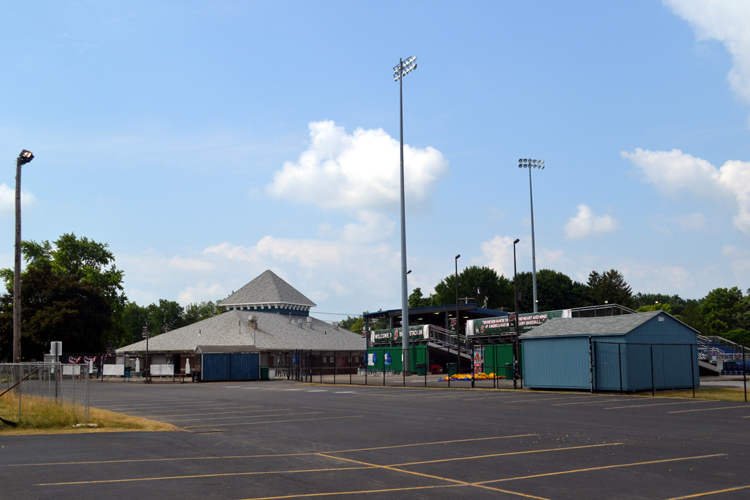




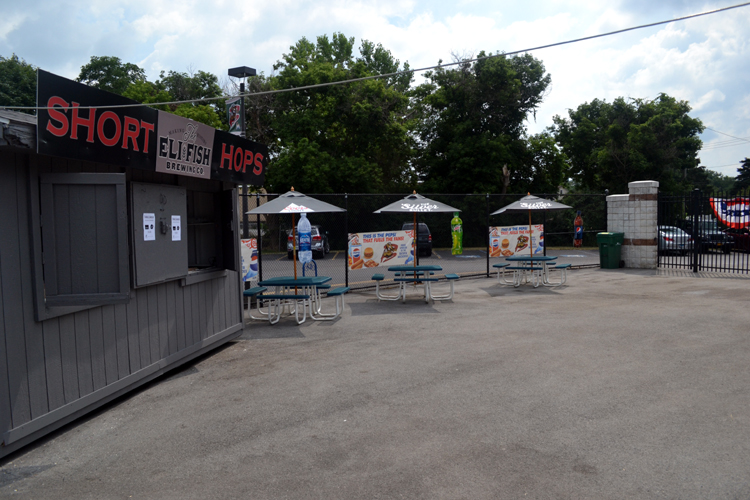




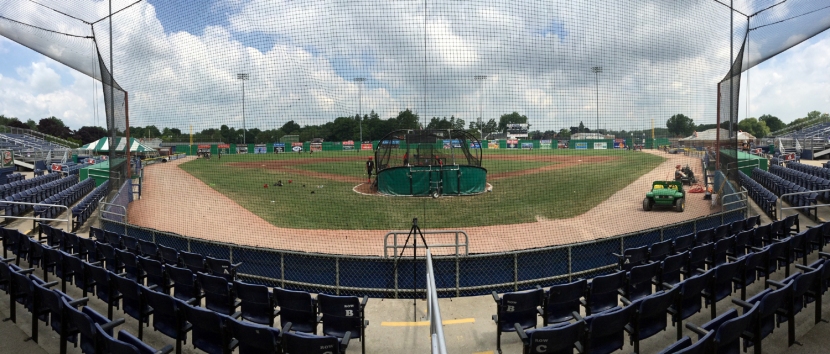







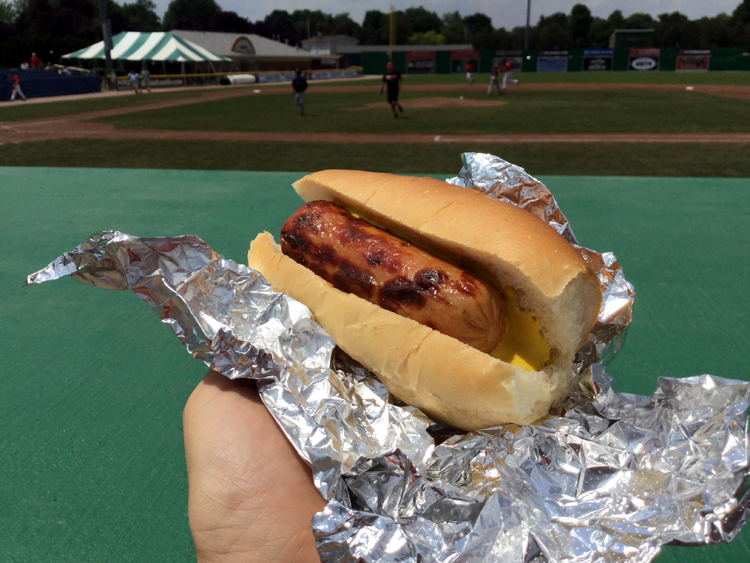


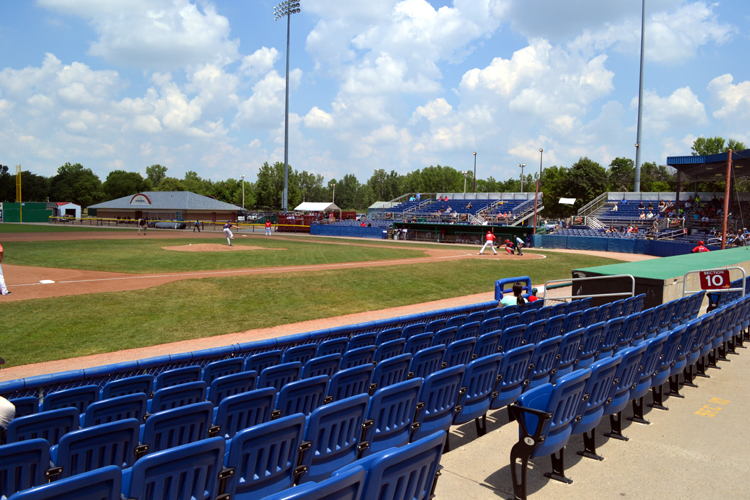





Really enjoy your posts, keep up the great work !!
Thanks for reading!
nice job
Thanks for checking out my blog.